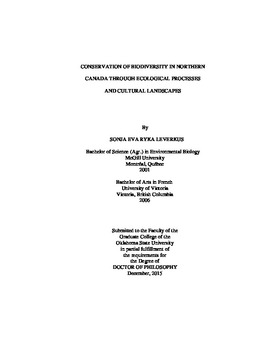| dc.contributor.advisor | Fuhlendorf, Samuel Dean | |
| dc.contributor.author | Leverkus, Sonja Eva Ryka | |
| dc.date.accessioned | 2016-09-29T18:45:42Z | |
| dc.date.available | 2016-09-29T18:45:42Z | |
| dc.date.issued | 2015-12 | |
| dc.identifier.uri | https://hdl.handle.net/11244/45363 | |
| dc.description.abstract | Disturbance processes are critical to ecosystem function and resilience. Across a landscape, fire varies in space and time, which results in a shifting mosaic of patches with different fire return intervals and vertical structure, promoting habitat heterogeneity and biodiversity. The spatiotemporal distribution of fire across the boreal landscape is critical for many species. The number of fires and number of times a particular area has burned results in differences in vertical structure, species composition and openness. This patchwork mosaic of the Boreal forest has historically been a result of anthropogenic fire and lightning since the last Ice Age. Prescribed fire was traditionally used by First Nations in the region and has been continued by guide outfitters in mountainous portions of the Boreal forest of northeastern British Columbia. In recent years, energy development in the region has resulted in a static mosaic of disturbance in the Boreal forest resulting in a series of linear and non-linear development disturbances. The cultural landscape of open vegetation cover across the Boreal is a result of anthropogenic disturbance (prescribed fire and energy development) and wildfire. We studied nearly one century of fire data (wildfire and prescribed fire) across three scales to determine the fire history of northeastern British Columbia. We found that most north-facing slopes experience infrequent fire while some south-facing slopes in certain watersheds have a higher fire frequency from anthropogenic burning. Within the region, we also studied the distribution of endangered native herbivores, wood bison (Bison bison athabascae), and domestic herbivores, horses (Equus callabus). We used six herds of animals occupying six distinct landscapes to evaluate the role of fire and energy development on boreal vegetation use by free-ranging herbivores from 2009 - 2013. Using Resource Selection Functions (RSFs) and models to evaluate spatial distribution of horses and bison across the landscapes, we found that free-ranging herbivores generally preferentially selected open areas, recently burned areas and areas burned more frequently when they were available. Bison congregated along both linear (i.e., roads) and non-linear (i.e. petroleum exploration sites) development features. However, selection for these modified landscapes has led to significant death from vehicle collisions. Alternative areas could be developed through activities that promote openings such as the implementation and continuation of prescribed fire or clearing of land. Disturbance processes resulting in openness are important for native and domestic herbivores. Prescribed fire and the ecological processes associated with it, including pyric herbivory, are important considerations when managing rangelands in northeastern British Columbia. Understanding fire patterns can aid in fire management and conservation of biodiversity in this region which is best described by a shifting mosaic fire regime. | |
| dc.format | application/pdf | |
| dc.language | en_US | |
| dc.rights | Copyright is held by the author who has granted the Oklahoma State University Library the non-exclusive right to share this material in its institutional repository. Contact Digital Library Services at lib-dls@okstate.edu or 405-744-9161 for the permission policy on the use, reproduction or distribution of this material. | |
| dc.title | Conservation of biodiversity in Northern Canada through ecological processes and cultural landscapes | |
| dc.contributor.committeeMember | Geertsema, Marten | |
| dc.contributor.committeeMember | Engle, David M. | |
| dc.contributor.committeeMember | Elmore, R. Dwayne | |
| dc.contributor.committeeMember | Baum, Kristen | |
| osu.filename | Leverkus_okstate_0664D_14380.pdf | |
| osu.accesstype | Open Access | |
| dc.type.genre | Dissertation | |
| dc.type.material | Text | |
| thesis.degree.discipline | Natural Resource Ecology and Management | |
| thesis.degree.grantor | Oklahoma State University | |
